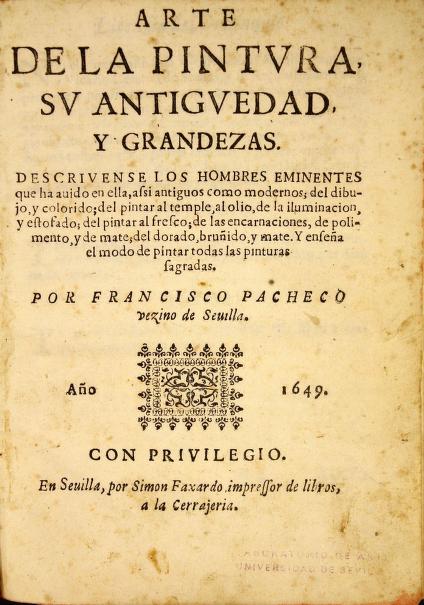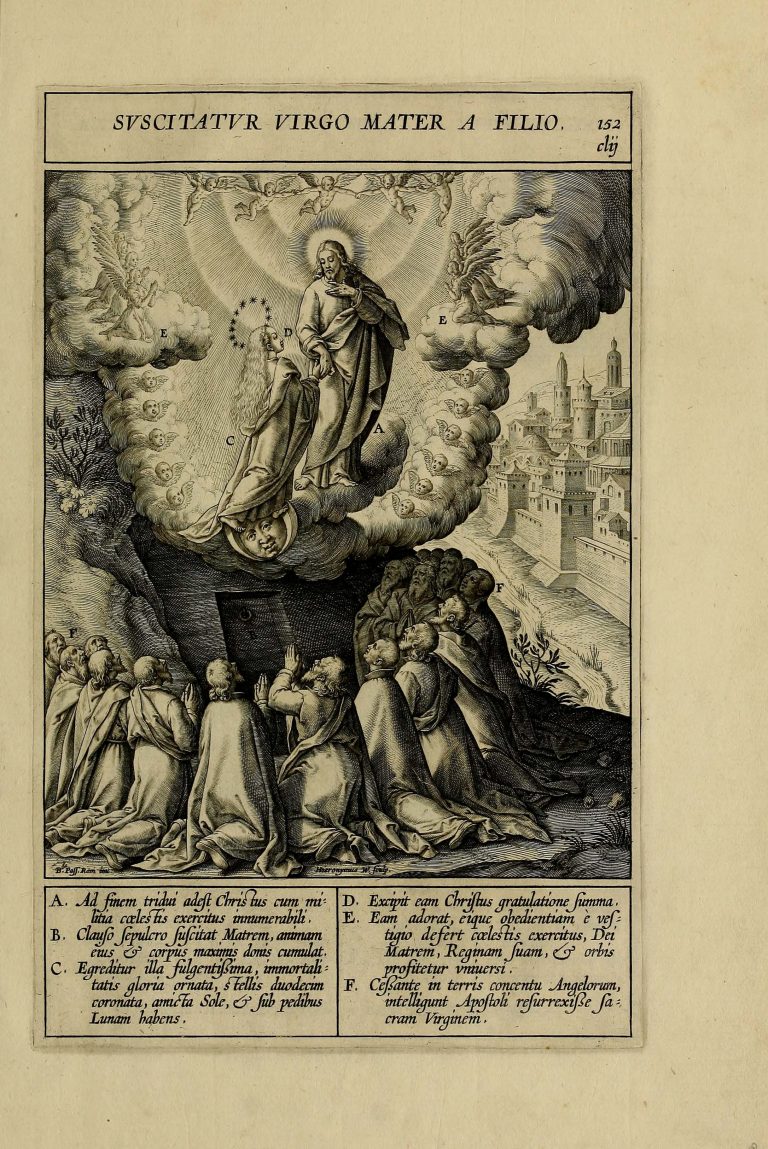
Frostispiece of Pacheco, El Arte de la pintura (1649), Seville, Simon Faxardo, impressor de libros, a la Cerrajeria
When Pacheco analysed how to depict the scene of the Assumption of Mary, the author states that representing Mary handled by the angels is not just an inadequate manner of depicting a such scene, but also a lack of decorum – since she ascended through the air without needing the angels to help her ascend or to carry her. An example of such an error was made by the artist El Mudo in the first painting of the Assumption of the Virgin seen at El Escorial.
“[…] To paint in this ascent the Virgin surrounded by angels, who seem to be helping her and raising her body, is not because she ascended with the virtue of the angels nor was this necessary since a glorious body by its virtue and gifts can do so, but to make it clear that these divine spirits accompanied her in the ascent with the pomp and glory due to her majesty, with which she was received in heaven by the whole of the Holy Trinity; […] She was reclining on her beloved, says Father Ribadeneira, by whose virtue, and by that of her blessed soul and her glorious body, she ascended through the air with great speed, without needing the angels to help her ascend or to carry her, although all accompanied, assisted and served her. […] and this is our warning: Let the angels accompany her with reverence and celestial music, but let them not hold her by the hand or carry her, as is indecently depicted. […] although the most common thing is to paint the Virgin alone, with her hands in her hands, accompanied by angels, not with a hand, which is what we correct again; warning, also, that it is very reasonable to paint her very beautiful and much younger than her age; because virginity preserves her beauty and exterior freshness, as is seen in many elderly nuns. Moreover, this sovereign Lady was free of all illness and accidents that could wither her beauty and, therefore, she should be painted as being thirty years old; adding to this the gifts of glory after her admirable resurrection. This was the error that El Mudo made in the first painting of the Assumption of Our Lady at El Escorial; and he would like, if the King would permit him, to erase it and make another, because it seemed to him that the Blessed Virgin was too tightly packed with the angels who were carrying her and so wrapped up in them that there was little authority and little grace, as Father Cigüenza well noted. Here it remained to finish off with the painting of the Last Judgement, but everything we had to note in it is dealt with at length in our second book, speaking of the part of decorum, where we refer to the lictors”.
“[…] pintar en esta subida a la Virgen rodeada de ángeles, que parece que le están ayudando y levantando su cuerpo, no es porque con la virtud de los ángeles subiese ni fuese esta menester, pues un cuerpo glorioso por su virtud y dotes lo puede hacer, sino para dar a entender que estos divinos espíritus le acompañaban en la subida con la pompa y gloria debida a su majestad, con la cual fue recebida en el cielo de toda la Santísima Trinidad; […] Iba recostada sobre su querido, dice el P. Ribadeneira, por cuya virtud, y por la de su alma bienaventurada y de su cuerpo glorioso, subía por los aires con gran velocidad, sin tener necesidad que los ángeles le ayudasen a subir ni la llevasen, aunque todos la acompañaban, asistian y servian. […] y ésta es nuestra advertencia: Que le acompañen los angeles con reverencia y música celestial, pero que no la lleven asida ni manuseada, como se pinta indecentisimamente. […] si bien, lo más común, es pintar a la Virgen sola, puestas sus manos, acompañada de ángeles, no asidos, que es lo que corregimos de nuevo; advirtiendo, también, que es muy puesto en razón que se pinte muy hermosa y de mucho menos edad que tenía; por cuando la virginidad conserva la belleza y frescura exterior, como se ve en muchas religiosas ancianas. Además, que esta soberana Señora careció de toda enfermedad y de accidentes que pudiesen marchitar su hermosura y, así, se debe pintar como de treinta años; juntándose a esto los dotes de gloria después de su admirable resurrección. En este yerro cayó el Mudo en el cuadro primero de la Asumpción de Nuestra Señora en El Escorial; y quisiera, si el Rey le diera licencia, borrarlo y hacer otro, porque le pareció que la Santísima Virgen iba muy apretada de los ángeles que la llevaban y tan envuelta con ellos que fue poca autoridad poca gracia, como notó bien el P. Cigüenza. Aquí restaba rematar con la pintura del Juicio Universal, pero todo lo que teníamos que advertir en ella está tratado bien a la larga, en nuestro segundo libro hablando de la parte del decoro, donde remitimos a los letores”.

Pacheco 1990, 655, n.60, 62-66; Pacheco 1990, 658, n.69-70;



